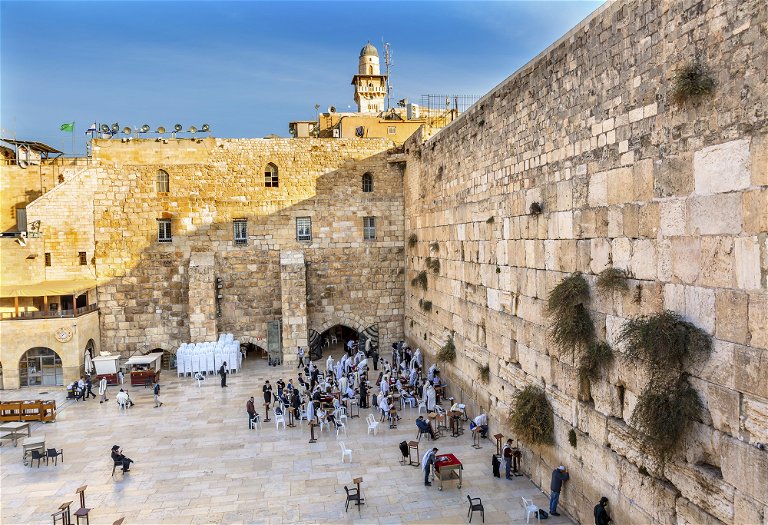Jerusalem: Mother of all flavours
For Jews, Christians and Muslims, Jerusalem is the "Holy City". And it is at the heart of the Israeli-Palestinian conflict. What unites all residents, regardless of their religion, is the food and their enthusiasm for it.
The old, narrow stone alleyways in Jerusalem's Old City are empty. Even at the Wailing Wall, only a few Jews are currently praying. And where it usually smells of oriental spices, oven-fresh rugelach, challah and pita, and where visitors can see pomegranates, lemons, figs, okra and peppers glowing in bright colours, at the Mahane Yehuda market in the centre, there are currently no people.
The small stores where tourists usually haggle with the owners for discounts on fabrics, jewellery and hookahs are almost all closed, the shutters down. Even in the cafés and bars that characterise the streets, there are only a few people. The fear of further attacks by Hamas is too great. Since the attacks by the Palestinian terrorist organisation on 7 October, tourists have also stopped coming to the city. Yet Jerusalem has always been one of the most popular travel destinations, especially in December.
How faith connects
During this month, Jews celebrate Hanukkah for eight days, the festival of lights commemorating the rededication of the Second Temple in Jerusalem in 164 B.C. Christians celebrate the birth of Jesus. And some Jews and Christians even celebrate "Chrismukkah" - as they call it - together, even though the two festivals have nothing to do with each other. They show that religion does not have to be something that divides; faith can also unite people, regardless of which god they worship and even if we are experiencing something different these months.
Sabbath sirens, bell ringing and muezzin calls have always been part of everyday life in Jerusalem. The "Holy City" with its eventful 4000-year history is the religious centre for Judaism as well as for Islam and Christianity.
For Christians, Jerusalem stands for the story of Jesus' suffering. The course of the Via Dolorosa is said to correspond to the route Jesus took from the place of his condemnation, the official residence of the Roman governor Pontius Pilate, to his crucifixion on Golgotha Hill. The Church of the Holy Sepulchre, the most important Christian shrine, was later built right there. It shows the place where Jesus' cross is said to have stood. It also contains the Holy Sepulchre and the anointing stone.

The Wailing Wall at the foot of the Temple Mount is the most important religious site for Jews. According to tradition, God chose this hill as his residence on earth. The Jewish King Solomon therefore had a temple built on it. Inside was a golden shrine containing the "holiest of holies": the stone tablet with the ten commandments of God. After its destruction, Herod the Great had it rebuilt at the beginning of the first century BC. The magnificent temple existed for less than a hundred years this time. The Romans destroyed it in 70 AD and expelled the Jews from the city. What remains, however, is the "Kotel", the mighty wall to which the faithful still come to pray today because they feel closest to God there.
The Temple Mount is just as important for Muslims as it is for Jews. On the stone plateau of "Al Haram al Sharif", as the hill is called in Arabic, Caliph Malik had the Dome of the Rock built in 690 AD, on the exact spot where the Jewish temple is said to have once stood. Why in this particular place? The political answer is to demonstrate power and the victory of the Islamic world over the Middle East.
But there is also a religious explanation: according to a legend based on Sura 17:1 of the Koran, Mohammed, the prophet, ascended to heaven from this rock. Muslims believe that his footprint can still be seen today. Only Muslims are allowed to enter both the Dome of the Rock and the Al-Aqsa Mosque, which is only a few metres away and is the third most important sanctuary after Mecca and Medina. And only they are allowed to pray there. The Muslim-Jordanian foundation "Waqf" has religious sovereignty over the four-hectare area on the Temple Mount, but the Israelis have territorial sovereignty. Conflicts are therefore a daily occurrence in this city, which is so fascinating due to its diversity and cultural richness.

Culinary worlds
"Four thousand years of bitter political and religious struggle have left their mark. Wherever you go - to the Jewish neighbourhoods or the historic Old City - people are fighting fiercely and passionately to protect and preserve what they see as their territory, their endangered culture or their right to a certain lifestyle," say Yotam Ottolenghi and Sami Tamimi. "But the passion and energy that the people of Jerusalem have in abundance is also reflected in fantastic food and extraordinary culinary creativity."
The two famous Chefs should know because they grew up in Jerusalem; one in the Jewish western part, the other in the Muslim eastern part. That's why they never met in their home town. Unfortunately, as sad as it is, food and the enthusiasm for it seem to be the only thing that unites people in this extremely divided city at the moment, say the two. Because Jerusalem's tastes and smells are, so to speak, the mother tongue of all, they know no boundaries.
Of course, every culture has its own specialities and delicacies. If you compare the dishes that a Palestinian mother cooks for her family in At-Tur in East Jerusalem with those that are served in the ultra-Orthodox quarter of Me'a She'arim, you might think that the culinary worlds have absolutely nothing to do with each other. It would never occur to Palestinians to combine savoury with sweet. In Jewish cuisine, especially that of the Sephardim, this is common practice (see recipe "Braised veal with prunes and leeks").
But a closer look reveals that the similarities in taste outweigh the differences. Chopped tomato and cucumber salad, which - depending on who serves it - is called Israeli or Arabic salad, is an indispensable standard dish, both at lunchtime and in the evening. And everyone, whether Orthodox or liberal Jews, Palestinian Muslims, Roman Catholics or Russian Orthodox Christians - to name just a few groups in this colourful melting pot - is cooking with the same ingredients. Ingredients that the region offers them: olives, lemons, artichokes, celery, green beans, peppers, zucchinis, eggplants, lentils, various herbs as well as nuts, figs, plums, apricots and much more.
Hummus and vegetables stuffed with rice or meat are also prepared in all neighbourhoods of the city. "In the past, and to some extent still today," says Yotam Ottolenghi, "it was and still is customary in Jewish and Arab families for the women to get together to prepare stuffed vegetables."
Hoping for peace
Due to the city's location on the edge of the Judean Desert, fish was only of minor culinary importance until the 20th century. It was mainly the Jews who came to Jerusalem in the last hundred years who made sure that fresh fish was available at the markets. The large aquariums with live fish that suddenly appeared in the 1950s were considered a sensation.
In the cookbook "The Flavor of Jerusalem", author Joan Nathan tells the following story: after the division of Jerusalem between Jordan and Israel in 1948, a barbed wire fence was drawn through the middle of the Arab village of Beit Safafa in the southwest of the city, separating friends and relatives. Until 1967, the inhabitants on the side facing Jordan were cut off from the Mediterranean and its fish. But the people on the other side of the barbed wire always managed to distract the soldiers at the fences with all kinds of tricks, and to slip a fish or two through the fence to their friends. Sometimes food can break down boundaries. Also in Jerusalem.
If not today, then perhaps tomorrow? The following psalm is written on an old stone wall south of the Temple Mount: "Wish Jerusalem happiness! May it be well with those who love you! May there be peace within your walls and happiness in your palaces!"

